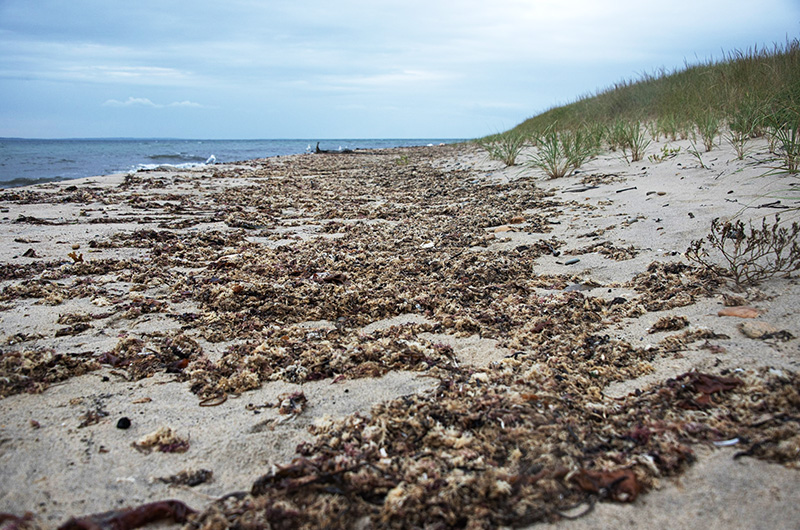Something smells rotten in Aquinnah.

For much of the past summer, residents of the tiny up-Island town have been plagued by a foul odor wafting from the normally pristine beaches near Dogfish Bar. It has been detected as far away as Philbin Beach, Old South Road, the Cliffs and the Circle. Town hall has been smelling it too, and has received upwards of 40 calls about it.
Beachside renters have spent vacations trapped in their homes and left asking for their money back.
“The smell is just horrendous,” selectman Gary Haley said at a recent selectman’s meeting. “It’s rancid, and smells like bad septic. When we had the wind blowing it smelled across the whole town. Some people said the smell was so bad that it was tough to sleep, that it was unbearable.”
The smell has been at its worst when the wind is blowing from the north or northeast, according to widespread reports from townspeople.
In late August the town board of health investigated, zeroing in on Oxcart Road, a low-lying area running west of Lobsterville Beach, north of Lighthouse Road. There was some concern that a septic system or septic systems had failed in the wetlands. In a letter to the selectmen on August 29, chairman James Glavin said the board found that in fact a series of natural factors had combined to create the problem.
“Exploring the [Oxcart Road] neighborhood, it was found that various areas in the wetland — or swamp, if you prefer — were unquestionably the source [of the stink],” he wrote. “Our theory is that since the water level in the wetland had been so high this year, this allowed an inordinate amount of anaerobic bacteria to thrive in the extended spring flooding, generating an increased amount hydrogen sulfide, a waste product of the oxidation of organic matter by such bacteria.”
The board concluded that the smell was not a public health issue, “but is endemic to the nature of that swamp,” Mr. Glavin wrote.
The town may want to commission an engineering survey of the area, he also said.
In a letter sent to the selectmen two days earlier, Hugh Taylor, a longtime resident of Lighthouse Road, offered his own suggestions and underscored the changes in natural processes that have occurred at Dogfish Bar over the decades.
“During our memorable past on Dogfish Bar, I had always believed that a canal, typical to numerous wetland roadways, should be dug along the inland side of the road, making clear culverts under any driveways that extend inland from the road,” Mr. Taylor wrote in part. “This sand and cobble spoil would raise the road above the common flooding and allow a watercourse for the excess swamp water.” He continued:
“A proactive effort like this is now necessary to mitigate the fact that, with the astonishing build out of the beaches of Dogfish Bar, the swamp waters can no longer leach northward . . . to the sound. In the 1950s the barrier was about 150 feet from the swamp to the mean high water of Vineyard Sound . . . today it is nearly 1,000 [feet].”
In the aftermath of the board of health report, Mr. Haley conducted his own investigation and concluded that the problem was stemming from large piles of rotting Irish moss seaweed on the beach.
“I went down there by Oxcart lane and investigated,” Mr. Haley told his colleagues on the board. “It’s seaweed. We had a huge buildup this year.”
He said there has been an unusually large bloom of a reddish-brown, broccoli-like seaweed from Philbin Beach around the Cliffs to Dogfish Bar. While the peninsular Island town is no stranger to seaweed, Mr. Haley said this summer was different.
“Normally it only stays for a few weeks, but this summer, probably because of the heat, we had seaweed all summer long,” the selectman said. “Now it’s really accumulated. And I’ve asked some of the old timers, and they said they’ve never had a smell like this before where it came all the way around town.”
On the beaches off Ox Cart Road this week, the seaweed was nearly three feet deep. Not only was it difficult to see the sand, it was difficult to smell the beach’s characteristic salt brine.
The town has sent samples of the seaweed to the Woods Hole Oceanographic Institution, and is awaiting the results.
Emily Reddington, a biologist and director of the Great Pond Foundation in Edgartown, affirmed that hydrogen sulfide from organic matter waste could be responsible for the stench. She also said an usually hot July could act as an incubator for the outgrowth of organic material.
Selectman Jim Newman said Monday that he went to Lobsterville Beach over the weekend and did not smell the odor, hoping that the recent storm had blown some of the decaying flora to sea.
“The first thought was that it was septic,” he said. “But no one had found anything that would definitively point to it being septic . . . I know if it persists we’re going to have to do something about it.”
Meanwhile, town administrator Jeffrey Madison summed up the prevailing sentiment in a note that accompanied the late August letters from the board of health and Mr. Taylor.
“Let us all hope that the weekend breeze is out of the south which will carry the smell out to Vineyard Sound,” he wrote.








Comments (7)
Comments
Comment policy »